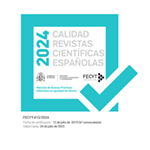Music programs on television: An oasis beyond talent shows
Abstract
After having up to eighteen music programs on the Spanish television schedule, over the last decade live music has been gradually taken off the air, with the exception of the omnipresent talent contests and the New Year’s Eve special. Recently, this trend seems to be reversing with the introduction of new shows such as Banana Split and Un país para escucharlo (both on Spanish television’s secondary public channel ‘La 2’). However, in October 2018 the most notable change occurred with the broadcast of a primetime live music program, La Hora Musa, on ‘La 2’, and Sesiones Movistar+, a program dedicated each week to a specific group or artist and broadcast on a private channel. Both projects were launched with the aim of resuscitating concerts and interviews on the small screen. The objective of this research was to explore the dimension and content of these two programs, contextualizing them and conducting a comparative analysis that allowed us to explore if past music programming formats have been recovered or if, on the contrary, a structural renewal has taken place. In terms of methods, in addition to a review of bibliographic and audio-visual sources, a content analysis of the first season of both programs was conducted, along with semi-structured interviews with the program managers and musicians who had played on the shows. In the conclusions, we highlight the significant similarities between both programs, although the program hosted on public television channel stands out for a greater variety of music genres and international artists, as well as the emergence of new opportunities for professionals in music journalism.
Downloads
Publication Facts
Reviewer profiles N/A
Author statements
- Academic society
- N/A
- Publisher
- Grupo de Investigación Cultura Digital y Movimientos Sociales. Cibersomosaguas
Article download
License
In order to support the global exchange of knowledge, the journal Teknokultura is allowing unrestricted access to its content as from its publication in this electronic edition, and as such it is an open-access journal. The originals published in this journal are the property of the Complutense University of Madrid and any reproduction thereof in full or in part must cite the source. All content is distributed under a Creative Commons Attribution 4.0 use and distribution licence (CC BY 4.0). This circumstance must be expressly stated in these terms where necessary. You can view the summary and the complete legal text of the licence.













